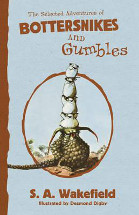The selected adventures of Bottersnikes and Gumbles by S. A. Wakefield

Ill. by Desmond Digby. HarperCollins, 2016. ISBN 9781460751923
Deep in the Australian bush, in rubbish heaps along dusty roadsides
live the Bottersnikes. They are extremely lazy and so rather than
building nests, digging burrows or even looking for hollows in trees
for shelter, they just cover up with the detritus of the rubbish
heaps that are so often found along country roads. Much of the time
they just sleep, blending into the landscape with their green
wrinkly skin, cheese-grater noses and long pointed ears that go red
when they are angry. But should something need doing, they would
rather spend their time trying to catch the cheerful Gumbles to do
it for them than do it themselves.
The Gumbles are polite, always ready to lend a hand but also rather
naive so they are perfect prey for the indolent Bottersnikes. The
adventures begin when one morning when a thistle growing through his
watering can wakes the King of the Bottersnikes but instead of just
pulling it out, he roars for someone to open the door of a nearby
rusting car so he can move into that. Being who they are the Gumbles
who were passing by agree to help, and the King realises that they
could be very useful servants in the future. So he orders the other
Bottersnikes, who have been woken by his roaring to grab them. And
when they do, they discover that Gumbles can be squashed into any
shape without being hurt, even flattened to pancake thinness, but
they can't return to their regular shape without help. By squishing
them into the empty cans that are lying around, they can be kept as
slaves, on hand for whenever there is something that needs doing!
Trapped and forced to work for these odious creatures was not what
the Gumbles had planned but unable to get out of the cans, their
future looks sealed. But the King did not see a little Gumble -
Tinkingumble, a wise little creature who has 'tinks' which come to
him with the sound of a spoon tapping a glass, who was fiddling with
a can-opener and worked out how to free his friends. So when the
Bottersnikes went to sleep for the night, the Gumbles escaped
although their giggling nearly thwarted their plans.
While they do escape successfully and free themselves of the cans,
which they neatly put in an official rubbish bin, the Bottersnikes
are now aware of them and their potential and so the book comprises
a series of discrete, complete stories of Bottersnikes vs Gumbles
that have delighted the children I've read them to over the years.
The stories are a wonderful springboard for environmental studies
focusing on understanding the effect of our actions on the
environment and how we manage and protect resources as well as an
excellent basis for collaborative mural-making project as the
children create their own Bottersnikes using Wakefield's description
and junk materials and Gumbles by stuffing and stitching pieces of
old stockings. Each day we collected the rubbish scattered in the
playground and added it to the mural and after just one week we had
a powerful statement to present to the rest of the school that had a
significant impact on the litter problem. With a recent television
series and movie (sneak peek)
which give great scope for exploring the interpretation of the same
story through different media, this story, which has been out of
print for some time, is now firmly back into the lives of our
younger readers.
Barbara Braxton